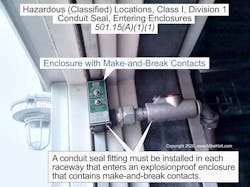Courtesy of www.MikeHolt.com
All questions and answers are based on the 2020 NEC.
Q. What does the Code require for raceway and cable seals in Class I locations?
See answer below.
A. Seals for raceway and cable systems must comply with Sec. 501.15(A) through (F) [Sec. 501.15].
Note 1: Raceway and cable seals must be installed to:
- Minimize the passage of gases and vapors from one portion of electrical equipment to another through the raceway or cable.
- Minimize the passage of flames from one portion of electrical equipment to another through the raceway or cable.
- Limit internal explosions to within the explosionproof enclosure.
(A) Raceway Seal — Class I, Division 1. In Class I, Division 1 locations, raceway seals must be located as follows:
(1) Entering Enclosures. A raceway seal is required in each raceway that enters an explosionproof enclosure if either (1) or (2) apply:
(1) If the explosionproof enclosure contains make-and-break contacts (Figure).
Exception: A raceway seal is not required if the make-and-break contacts are:
(1) Within a hermetically sealed chamber.
(2) Immersed in oil in accordance with Sec. 501.115(B)(1)(2).
(3) Contained within an enclosure that is marked “Leads Factory Sealed,” “Factory Sealed,” “Seal not Required,” or the equivalent.
These materials are provided to us by Mike Holt Enterprises in Leesburg, Fla. To view Code training materials offered by this company, visit www.mikeholt.com/code.






